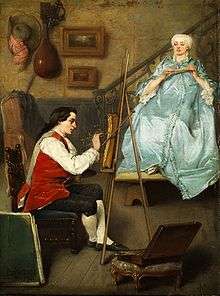Eugène Fichel
Benjamin Eugène Fichel (30 August 1826 Paris - 2 February 1895 Paris) son of Moise Mayer Fichel and Lili Abigail Sasias, was a French painter.

Biography
He entered the École des Beaux-Arts in 1844 and became a pupil of Hippolyte Delaroche, but painted very much more under the inspiration of Jean-Louis-Ernest Meissonier, whose exquisite handling is suggested in numerous small canvases of his which by their refined technique and vivid action recall the characteristic intensity and directness of composition which belong to the painter of "Friedland." His students included Jeanne Fichel who he later married.[1]
Along with great care in finish, Fichel's canvases also exhibit an archæological exactness, and a kind of delicate humor. His first work of importance was exhibited in 1850, "Harvey Demonstrating the Circulation of the Blood to Charles I." He was a chevalier of the Legion of Honor and, in 1857, received a medal for his painting in the Salon of that year. He exhibited a canvas every year at the Salon, up to a few years before his death.
Works
The principal works of Fichel are genre paintings, and include "The End of Dinner," "A Festival in the Year 1776," "The Capture of a Spy," "The Wandering Singers," "A Morning Call," "The Arrival at the Inn," "The Council of War" and others. He also did history paintings which have the freedom and imagination of pure genre: "The Night of August 24, 1572" and "Founding of the French Academy." Many of his pictures are in galleries all over the world. Two of his paintings, "A Violin Player," executed in 1871, and "Awaiting an Audience," painted in 1881, are in the New York Metropolitan Museum of Art
Notes
References
| Wikimedia Commons has media related to Benjamin Eugène Fichel. |
- Rines, George Edwin, ed. (1920). . Encyclopedia Americana. This work in turn cites:
- Montrosier, E., Les Artistes Modernes (Vol. IV, Paris 1884)
- Gilman, D. C.; Peck, H. T.; Colby, F. M., eds. (1905). . New International Encyclopedia (1st ed.). New York: Dodd, Mead.